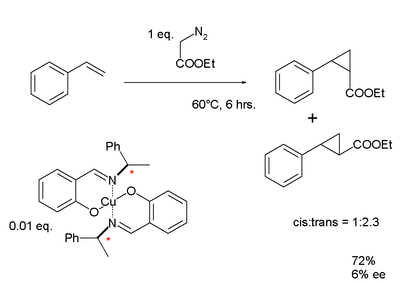Schiff base

-skeletal.png)
A Schiff base (named after Hugo Schiff) is a compound with the general structure R2C=NR' (R' ≠ H).[1][2] They can be considered a sub-class of imines, being either secondary ketimines or secondary aldimines depending on their structure. The term is often synonymous with azomethine which refers specifically to secondary aldimines (i.e. R-CH=NR' where R' ≠ H).[3]
A number of special naming systems exist for these compounds. For instance a Schiff base derived from an aniline, where R3 is a phenyl or a substituted phenyl, can be called an anil,[4] while bis-compounds are often referred to as salen-type compounds.
The term Schiff base is normally applied to these compounds when they are being used as ligands to form coordination complexes with metal ions. Such complexes occur naturally, for instance in Corrin, but the majority of Schiff bases are artificial and are used to form many important catalysts, such as Jacobsen's catalyst.
Synthesis
Schiff bases can be synthesized from an aliphatic or aromatic amine and a carbonyl compound by nucleophilic addition forming a hemiaminal, followed by a dehydration to generate an imine. In a typical reaction, 4,4'-diaminodiphenyl ether reacts with o-vanillin:[5]

Biochemistry
Schiff bases are common enzymatic intermediates where an amine, such as the terminal group of a lysine residue, reversibly reacts with an aldehyde or ketone of a cofactor or substrate. The common enzyme cofactor PLP forms a Schiff base with a lysine residue and is transaldiminated to the substrate(s).[6] Similarly, the cofactor retinal forms a Schiff base in rhodopsins, including human rhodopsin (via Lysine 296), which is key in the photoreception mechanism.
An example where the substrate forms a Schiff base to the enzyme is in the fructose 1,6-bisphosphate aldolase catalyzed reaction during glycolysis and in the metabolism of amino acids.
Coordination chemistry
Schiff bases are common ligands in coordination chemistry. The imine nitrogen is basic and exhibits pi-acceptor properties. The ligands are typically derived from alkyl diamines and aromatic aldehydes.[7]
2.png)

.png)
Chiral Schiff bases were one of the first ligands used for asymmetric catalysis. In 1968 Ryōji Noyori developed a copper-Schiff base complex for the metal-carbenoid cyclopropanation of styrene.[8] For this work he was later awarded a share of the 2001 Nobel Prize in Chemistry. Schiff bases have also been incorporated into MOFs.[9]

Conjugated Schiff bases
Conjugated Schiff bases absorb strongly in the UV-vis region of the electromagnetic spectrum. This absorption is the basis of the anisidine value, which is a measure of oxidative spoilage for fats and oils.
References
- ↑ IUPAC, Compendium of Chemical Terminology, 2nd ed. (the "Gold Book") (1997). Online corrected version: (2006–) "Schiff base".
- ↑ See:
- Schiff, Hugo (1864). "Mittheilungen aus dem Universitäts-laboratorium in Pisa: 2. Eine neue Reihe organischer Basen" [Communications from the university laboratory in Pisa: 2. A new series of organic bases]. Annalen der Chemie und Pharmacie (in German). 131: 118–119. doi:10.1002/jlac.18641310113.
- Schiff, Ugo (1866). "Sopra una nova serie di basi organiche" [On a new series of organic bases]. Giornale di scienze naturali ed economiche (in Italian). 2: 201–257.
- Schiff, Hugo (1866). "Eine neue Reihe organischer Diamine" [A new series of organic diamines]. Annalen der Chemie und Pharmacie, Supplementband (in German). 3: 343–370.
- Schiff, Hugo (1866). "Eine neue Reihe organischer Diamine. Zweite Abtheilung" [A new series of organic diamines. Second part.]. Annalen der Chemie und Pharmacie (in German). 140: 92–137. doi:10.1002/jlac.18661400106.
- ↑ IUPAC, Compendium of Chemical Terminology, 2nd ed. (the "Gold Book") (1997). Online corrected version: (2006–) "azomethines".
- ↑ IUPAC, Compendium of Chemical Terminology, 2nd ed. (the "Gold Book") (1997). Online corrected version: (2006–) "anils".
- ↑ Jarrahpour, A. A.; M. Zarei (February 24, 2004). "Synthesis of 2-({[4-(4-{[(E)-1-(2-hydroxy-3-methoxyphenyl)methylidene amino}phenoxy)phenyl imino}methyl)- 6 -methoxy phenol". Molbank. M352. ISSN 1422-8599. Retrieved February 22, 2010.
- ↑ Eliot, A. C.; Kirsch, J. F. (2004). "PYRIDOXALPHOSPHATEENZYMES: Mechanistic, Structural, and Evolutionary Considerations". Annual Review of Biochemistry. 73: 383–415. doi:10.1146/annurev.biochem.73.011303.074021. PMID 15189147.
- ↑ R. Hernández-Molina, A. Mederos "Acyclic and Macrocyclic Schiff Base Ligands" in Comprehensive Coordination Chemistry II 2003, Pages 411–446. doi:10.1016/B0-08-043748-6/01070-7
- ↑ H. Nozaki; H. Takaya; S. Moriuti; R. Noyori (1968). "Homogeneous catalysis in the decomposition of diazo compounds by copper chelates: Asymmetric carbenoid reactions". Tetrahedron. 24 (9): 3655–3669. doi:10.1016/S0040-4020(01)91998-2.
- ↑ F.J. Uribe-Romo; J.R. Hunt; H. Furukawa; C. Klock; M. O’Keeffe; O.M. Yaghi (2009). "A Crystalline Imine-Linked 3-D Porous Covalent Organic Framework". J. Am. Chem. Soc. 131 (13): 4570–4571. doi:10.1021/ja8096256. PMID 19281246.
Further reading
- J.C. Hindson; B. Ulgut; R.H. Friend; N.C. Greenham; B. Norder; A. Kotlewskic; T.J. Dingemans (2010). "All-aromatic liquid crystal triphenylamine-based poly(azomethine)s as hole transport materials for opto-electronic applications". J. Mater. Chem. 20 (5): 937–944. doi:10.1039/B919159C.
- M.L. Petrus; T. Bein; T.J. Dingemans; P. Docampo (2015). "A Low Cost Azomethine-Based Hole Transporting Material for Perovskite Photovoltaics". J. Mater Chem. A. 3 (23): 12159–12162. doi:10.1039/C5TA03046C. </ref> organic field-effect transistor (OFET)<ref>D. Isık; C. Santato; S. Barik; W.G. Skene (2012). "Charge-Carrier Transport in Thin Films of π-Conjugated Thiopheno-Azomethines". Org. Electron. 13 (12): 3022–3031. doi:10.1016/j.orgel.2012.08.018.
- L. Sicard; D. Navarathne; T. Skalski; W. G. Skene (2013). "On-Substrate Preparation of an Electroactive Conjugated Polyazomethine from Solution-Processable Monomers and its Application in Electrochromic Devices". Adv. Funct. Mater. 23 (8): 3549–3559. doi:10.1002/adfm.201203657.